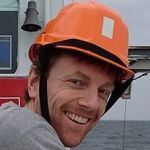Small eats smallest

When inorganic nutrients are pumped to the sunlit surface of the ocean, it will be taken up by microscopic plants called phytoplankton. Phytoplankton uses the energy from sunlight to transform CO2 to sugar during photosynthesis. They also need inorganic nutrients, in particular nitrogen and phosphorus to grow and reproduce. Part of the phytoplankton biomass is eaten by grazers, like a cow eating grass, and the biomass travels up the food chain all the way to fish and marine mammals.
One of the differences between marine and land ecosystems is that in the ocean there are a lot more levels of grazers and predators. On land, a salad eating rabbit could be eaten by a wolf which is the top predator. This equals three trophic levels: salad, rabbit and wolf. In the ocean there could be five or more trophic levels before reaching a top predator such as shark or dolphin. Trying to disentangle who eats what and how much is difficult, but central to understanding material fluxes and functioning of marine ecosystem.
In this experiment, we are trying to quantify the amount of grazing by the smallest kind of grazers that are called microzooplankton. These are often similar sized or only marginally larger than the phytoplankton they eat, ranging from a few- up to two-hundred micrometers, which is 2/10 of a millimeter. For doing this, we count the microscopic organisms with a flow cytometer. Originally developed to count blood cells, a flow cytometer creates a stream of the sample water that the passes a light beam from a laser. The properties of the passing particles are recorded, one of which is the scattering signal - sort of the shade the particle creates when passing the light beam. In addition, phytoplankton contains chlorophyll, which is fluorescent, and this is also recorded. In a separate incubation, we monitor the phytoplankton counts over time and from this we estimate the growth and grazing of these smallest of the plants in the ocean.

